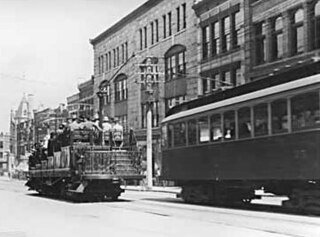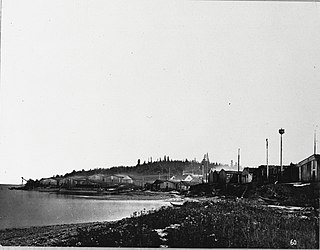| Company type | Private |
|---|---|
| Industry | Banking, Financial services |
| Founded | 1862 - 1901 (first bank) (merged with Canadian Bank of Commerce); 1966 - 1986 (second bank) (rescued and merged into Hongkong Bank of Canada) |
| Headquarters | British Columbia , Canada |
Two Canadian banks have been named the Bank of British Columbia.
The first one was established by Royal Charter in 1862, with its head office in London. [1] Between 1862 and 1871, it issued dollar banknotes. By 1885, branches operated in San Francisco, [2] Portland (est. 1866), Victoria (est. 1862) and New Westminster (est. 1862). In 1889, a branch was established in Seattle. In 1901, it merged with the Canadian Bank of Commerce. [3] At the time of the merger, branches existed in Vancouver (est. 1886), Victoria, Kamloops, Nanaimo, Nelson, New Westminster, Rossland, Sandon, San Francisco, Portland, and London.
There remains $48,797 in outstanding banknotes from the bank of British Columbia, in $1, $5, $10, $20 and $50 denominations. The bills were issued from 1863 to 1894 and in the 1970s they brought anywhere from $500 to $1,500 per bill on the collector's market. [4]
In British Columbia, the Victoria branch was built in 1885 and was designated as a heritage site by the City of Victoria in 1975. [5] The Vancouver branch was built in 1889 to 1891 and was added to Vancouver's Community Heritage Register in 1986. [6]
The second bank was chartered in 1966 with headquarters in Vancouver [7] and was the creation of W.A.C. Bennett, the Premier of British Columbia. Bennett, a businessman, wanted to end Central Canada's control over the banking industry, which obliged all but the smaller loans for companies in British Columbia to receive authorization from head offices in either Montreal or Toronto.
In 1986, the bank had 1,410 employees, 41 branches in BC and Alberta, and offices in the Cayman Islands, the US, and Hong Kong. Assets in 1986 were CAD$2.7 billion, which put the bank 27th among banks and financial institutions in Canada. Revenue in 1986 was $324 million.
Following financial difficulties arising from the decline of the western oil economy, the collapses of Canadian Commercial Bank and Northland Bank had a serious impact on other institutions that depended on wholesale deposit funding. Like the many Trust Companies and Credit Union amalgamations in 1986, the Canadian government permitted the Hongkong Bank of Canada (HSBC) to rescue it. [8]

The Bank of Montreal, abbreviated as BMO, is a Canadian multinational investment bank and financial services company.

New Westminster is a city in the Lower Mainland region of British Columbia, Canada, and a member municipality of the Metro Vancouver Regional District. It was founded by Major-General Richard Moody as the capital of the Colony of British Columbia in 1858 and continued in that role until the Mainland and Island colonies were merged in 1866. It was the British Columbia Mainland's largest city from that year until it was passed in population by Vancouver during the first decade of the 20th century.

The British Columbia Electric Railway (BCER) was a historic railway which operated in southwestern British Columbia, Canada. Originally the parent company for, and later a division of, BC Electric Company, the BCER assumed control of existing streetcar and interurban lines in southwestern British Columbia in 1897, and operated the electric railway systems in the region until the last interurban service was discontinued in 1958. During and after the streetcar era, BC Electric also ran bus and trolleybus systems in Greater Vancouver and bus service in Greater Victoria; these systems subsequently became part of BC Transit, and the routes in Greater Vancouver eventually came under the control of TransLink. Trolley buses still run in the City of Vancouver with one line extending into Burnaby.

The history of British Columbia covers the period from the arrival of Paleo-Indians thousands of years ago to the present day. Prior to European colonization, the lands encompassing present-day British Columbia were inhabited for millennia by a number of First Nations.

The Grand Trunk Pacific Railway was a historic Canadian transcontinental railway running from Fort William, Ontario to Prince Rupert, British Columbia, a Pacific coast port. East of Winnipeg the line continued as the National Transcontinental Railway (NTR), running across northern Ontario and Quebec, crossing the St. Lawrence River at Quebec City and ending at Moncton, New Brunswick. The Grand Trunk Railway (GTR) managed and operated the entire line.

Queensborough Bridge is a highway bridge in New Westminster, British Columbia. It was built in 1960 by John Laing and Son (Canada) for the City of New Westminster and cost $4 million. The bridge spans the north arm of the Fraser River for road access from the main part of New Westminster to the suburb of Queensborough at the east end of Lulu Island, giving the bridge its name.

Canadian Western Bank, also operating as CWB Financial Group, is a Canadian bank based in Edmonton, Alberta. The bank serves clients both in Western Canada and in other provinces. It was announced on June 11, 2024 that it would be acquired by National Bank of Canada in 2025.
HSBC Bank Canada, formerly the Hongkong Bank of Canada (HBC), was a British-Canadian chartered bank and the former Canadian subsidiary of British multinational banking and financial services company HSBC.

Powell River is a city on the northern Sunshine Coast of southwestern British Columbia, Canada. Most of its population lives near the eastern shores of Malaspina Strait, which is part of the larger Georgia Strait between Vancouver Island and the Mainland. With two intervening long, steep-sided fjords inhibiting the construction of a contiguous road connection with Vancouver to the south, geographical surroundings explain Powell River's remoteness as a community, despite relative proximity to Vancouver and other populous areas of the BC Coast. The city is the location of the head office of the qathet Regional District.

The Canada Deposit Insurance Corporation is a Canadian federal Crown Corporation created by Parliament in 1967 to provide deposit insurance to depositors in Canadian commercial banks and savings institutions. CDIC insures Canadians' deposits held at Canadian banks up to C$100,000 in case of a bank failure. CDIC automatically insures many types of savings against the failure of a financial institution. However, the bank must be a CDIC member and not all savings are insured. CDIC is also Canada's resolution authority for banks, federally regulated credit unions, trust and loan companies as well as associations governed by the Cooperative Credit Associations Act that take deposits.

The Bank of British North America was founded by royal charter issued in 1836 in London, England. British North America was the common name by which the British colonies and territories that now comprise Canada were known prior to 1867.
Barclays Bank has operated as a retail and commercial bank in Canada from 1929 to 1956, from 1979 to 1996, and most recently from 2010.
The Chartered Bank of India, Australia and China was a bank incorporated in London in 1853 by Scotsman James Wilson, under a Royal Charter from Queen Victoria.

Fort Rupert is the site of a former Hudson's Bay Company (HBC) fort on the east coast near the northern tip of Vancouver Island, British Columbia. The unincorporated community on Beaver Harbour is about 11 kilometres (7 mi) by road southeast of Port Hardy.

The following outline is provided as an overview of and topical guide to British Columbia:
The Bank of Vancouver was a Canadian chartered bank which operated 1910–1914 in British Columbia.
Vancouver City Savings Credit Union, commonly referred to as Vancity, is a member-owned financial co-operative headquartered in Vancouver, British Columbia, Canada. By asset size, Vancity is the largest community credit union in Canada as of 2019, with CA$28.2 billion in assets plus assets under administration, 60 branches and more than 543,000 members.
The history of Chinese Canadians in British Columbia began with the first recorded visit by Chinese people to North America in 1788. Some 30–40 men were employed as shipwrights at Nootka Sound in what is now British Columbia, to build the first European-type vessel in the Pacific Northwest, named the North West America. Large-scale immigration of Chinese began seventy years later with the advent of the Fraser Canyon Gold Rush of 1858. During the gold rush, settlements of Chinese grew in Victoria and New Westminster and the "capital of the Cariboo" Barkerville and numerous other towns, as well as throughout the colony's interior, where many communities were dominantly Chinese. In the 1880s, Chinese labour was contracted to build the Canadian Pacific Railway. Following this, many Chinese began to move eastward, establishing Chinatowns in several of the larger Canadian cities.
The Union Bank of Canada was a Canadian chartered bank which operated 1865–1925, primarily in the Canadian Prairies.